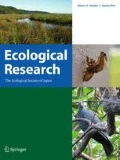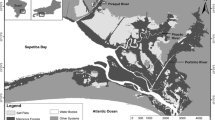Abstract
In order to determine the seasonal growth and biomass ofTrapa japonica Flerov, field observations were carried out at Ojaga-ike Pond, Chiba, Japan, during 1979 and 1980. In spring, the plant showed exponential growth (c. 0.080 g g−1 day−1) and shoot elongation was as rapid as 10 cm day−1. The plant attained its maximum biomass (380.5±35.1 g m−2) in late August, and about 50% of this was concentrated in the topmost 30-cm stratum (645.7±33.1 g m−3); maximum total stem length exceeded 6m. The plant produced large (500–800 mg per fruit), but small numbers of nut-like fruit (maximum, 5 fruits per rosette). Defoliation occurred almost linearly with time at a rate of 30.6 leaves m−2 day−1; annual net leaf production was estimated to be about twice as large as the seasonal maximum leaf biomass. While the number of leaves per rosette showed moderate seasonal change, rosette density, rosette area and leaf dry weight changed considerably during the year. From the negative log-log correlation between mean total leaf dry weight per rosette and rosette density, density-dependent rosette growth was assumed. The cause of the wide spread of this species in aquatic habitats is briefly discussed in terms of its seed size and morphology.
Similar content being viewed by others
References
Ambasht, R. S. &Ram, K. (1976) Stratified primary productive structure of certain macrophytic weeds in a large Indian lake. “Aquatic weeds in South East Asia” (ed. Varshney, C. K. & Rzóska, J.), 147–155. Junk, The Hague.
Begon, M., Harper, J. L. &Townsend, C. R. (1986) Ecology: individuals, populations and communities. 876 pp. Sinauer Associates, Inc. Sunderland, Massachusetts.
Cook, C. D. K. (1987) Dispersion in aquatic and amphibious vascular plants. “Plant life in aquatic and amphibious habitats” (ed. Crawford R. M. M.), 179–190. Blackwell, Oxford.
Fenner, M. (1985) Seed ecology. 151 pp. Chapman and Hall, London.
Gams, H. (1927) Die GattungTrapa L. Die Pflanzenareale3 (1): 39–41 (+3 figs.).
Hamashima, S., (1983) Correlation of the flora of aquatic macrophytes with the chemical contents of water in the irrigation reservoirs of Tokai District. Jpn. J. Limnol.44: 1–5 (In Japanese with English summary).
Hara, T., Koike, F. &Matsui, K. (1986) Crowding effect in marine macrophytic algae populations. Bot. Mag, Tokyo99: 319–321.
Harper, J. L. (1977) Population biology of plants. 892 pp. Academic Press, London.
Hayashi, I. (1977) Secondary succession of herbaceous communities in Japan. Jpn. J. Ecol.27: 191–200.
Hayashi, K. (1983) Life cycles and mechanisms of population maintenance in floating-leaved annual plants. M. Sc. Thesis. Ibaraki University. 96+35 p. (In Japanese).
Ikusima, I. (1970) Ecological studies on the productivity of aquatic plant communities IV. Light condition and community photosynthetic production. Bot. Mag. Tokyo83: 330–341.
Iwakuma, T. &Tsuchiya, T. (1986) An experimental study of nutrient removal from lake water by a floating-leaved plant,Trapa natans. Res. Rep. Natl. Inst. Environ. Stud., Jpn.96: 101–125 (In Japanese with English summary).
Janković, M. M. (1955a) Beitrag zur Kenntnis der individuellen Entwicklung der Wassernuss (Trapa L.). I. Die Frage der Abrezung der individuellen Entwicklung der Wassernuss nach Stufen. Arch. Sci. Biol. (Beograd)7: 15–23.
— (1955b) Résultats et méthode des recherches effectuées jusqu'a présent en Yugoslavie sur le genreTrapa L. Arhiv Bioloskih Nauka (Beograd)7: 47–67.
— (1956a) Beitrag zur Kenntnis der individuellen Entwicklung der Wassernuss (Trapa L.). II. Sekundär-submerse Blätter. Arch. Sci. Biol. (Beograd)8: 9–19.
—. (1956b) Beitrag zur Kenntnis der individuellen Entwicklung der Wassernuss (Trapa L.). III. Seitliche Verzweigung. Arch. Sci. Biol. (Beograd)8: 81–86.
Juget, J. &Rostan, J. C. (1973) Influence des herbiers aTrapa natans sur la dynamique d'un etang en periode estivale. Annls. Limnol.9: 11–23.
Kadono, Y. (1982) Occurrence of aquatic macrophytes in relation to pH, alkalinity, Ca++, Cl− and conductivity. Jpn. J. Ecol.32: 39–44.
—. (1984) Aquatic macrophytes of the irrigation reservoirs in East Harima Province, Hyogo Prefecture, Southwestern Japan. J. Phytogeogr. and Taxon.32: 127–135 (In Japanese with English summary).
—. (1987) A preliminary study on the variation ofTrapa in Japan. Acta Phytotax. Geobot.38: 199–210 (In Japanese with English summary).
—, (1986) Floral biology ofTrapa natans var.japonica. Bot. Mag. Tokyo99: 435–439.
Kawano, S. (1981) Trade-off relationships between some reproductive characteristics in plants with special reference to life history strategy. Bot. Mag. Tokyo94: 285–294.
Koidsumi, K., Sakurai, Y. &Kawashima, S. (1967) Standing crop of higher aquatic plants in Lake Suwa (Materials for the limnology of Lake Suwa 1). Jpn. J. Limnol.28: 57–63 (In Japanese with English summary).
Kunii, H. (1982) Life cycle and growth ofPotamogeton crispus L. in a shallow pond Ojaga-ike. Bot. Mag. Tokyo95: 109–124.
— (1983) Diurnal vertical fluctuations in some water variables under the covers of two different aquatic plants,Elodea nuttallii andTrapa sp. Mem. Fac. Sci. Shimane Univ.17: 61–69.
—. (1984a) Seasonal changes in water quality and surface cover of aquatic plants in Pond Ojaga-ike, Chiba, 1978–1980. Mem. Fac. Sci. Shimane Univ.18: 59–68.
— (1984b) Seasonal growth and profile structure development ofElodea nuttallii (Planch.) St. John in pond Ojaga-ike. Aquat. Bot.18: 239–247.
— (1988) Longevity and germinability of buried seeds inTrapa sp. Mem. Fac. Sci. Shimane Univ.22: 51–59.
— (1982) Seasonal and long-term changes in surface cover of aquatic plants in a shallow pond, Ojaga-ike, Chiba, Japan. Hydrobiologia87: 45–55.
— (1985) Preliminary report on the distribution of aquatic plants in and around Matsue City, Japan. Plant and Nature19: 31–34 (In Japanese).
Kurasawa, H., Okino, T., &Hayashi, H. (1979) Chronological changes in distribution and standing crop of rooted aquatic plants in Lake Suwa, “Studies on the relation between the establishment of the sewage system and the watershed of Lake Suwa” (ed. Kurasawa, H.) 7–26. Research Report of Environmental Studies. B20-R12-2 (In Japanese).
Lonsdale, W. M. &Watkinson, A. R. (1983) Plant geometry and self-thinning. J. Ecol.71: 285–297
Miki, S. (1927) Oekologische Studien über die Sumpf- und Wassergewächse sowie ihre Formationen im Ogura-Teiche. Report on the historical remains and scenic places in Kyoto8: 81–145. (In Japanese).
— (1952)Trapa of Japan with special reference to its remains. J. Inst. Polytech. Osaka City Univ. Ser. D3: 1–29 (+2 pl.).
—. (1953) Morphological character of remains ofTrapa and adaptation of aquatic life. Jpn. J. Ecol.2: 111–116 (In Japanese).
— (1959) Evolution ofTrapa from ancestralLythrum throughHemitrapa. Proc. Jpn. Acad.35: 289–294.
Momoshima, T. &Nakamura, D. (1979) Studies on water chestnut (Trapa natans L.). Bull. Saga Agr. Exp. St.19: 83–111 (In Japanese with English summary).
Muenscher W. C. (1936) Storage and germination of seeds of aquatic plants. Bull. Cornell Univ. Agr. Exp. St.652: 3–17.
Nakai, M. (1988) On the morphology of genusTrapa in and around Chita Peninsula, Aichi Prefecture. Bull. Water Plant Soc. Jpn.31: 2–6 (In Japanese).
Nakano, H. (1910) On the variation of JapaneseTrapa. Bot. Mag. Tokyo24: 383–387 (In Japanese).
— (1913) Beitrage zur Kenntnis der Variationen vonTrapa in Japan. Bot. Jahrb.50: 440–458.
— (1964) Further studies onTrapa from Japan and its adjacent countries. Bot. Mag. Tokyo77: 159–167.
Ohwi, J. (1972) Flora of Japan. 1560 pp. Shibundo, Tokyo.
Pijl, L. van der (1982) Principles of dispersal in higher plants. 214 pp. Springer-Verlag, Berlin.
Saha, S. C. (1986) Productivity of major Indian aquatic macrophytes. J. Aquat. Plant Manage.24: 93–94.
Sakaguchi, S. (1982) A report of the genusTrapa in Kagawa Prefecture, Japan (1). Kagawa Seibutsu10: 13–17 (In Japanese).
— (1983) A report on the genusTrapa in Kagawa Prefecture, Japan (2). Kagawa Seibutsu11: 35–39 (In Japanese).
Sculthorpe, C. D. (1967) The biology of aquatic vascular plants. 610 pp. Edward Arnold, London.
Shimoda, M. (1985) Phytosociological studies on the vegetation of irrigation ponds in the Saijo Basin, Hiroshima Prefecture, Japan. J. Sci. Hiroshima Univ., Ser. B, Div. 219: 237–297.
Srivastava, G. D. &Tandon, R. K. (1951) A study in the autecology ofTrapa bispinosa Roxburgii. Proc. Nat. Acad. Sci. India21: 57–66.
Staszkiewicz, J. &Wójcicki, J. J. (1979) Analiza biometryczna orzechów rodzajuTrapa L. z Polski. Fragmenta Floristica et Geobotanica25: 33–59.
Stephenson, A. G. (1981) Flower and fruit abortion: proximate causes and ultimate functions Ann. Rev. Ecol. System.12: 253–279.
Terasawa, Y. (1927) Experimentelle Studien über die Keimung der Samen vonTrapa natans L. Bot. Mag. Tokyo41: 581–588.
Toda, H. (1968) Memoir of water plants in Enshu District. I.Trapa. Mem. Hamamatsu City High School 87–96 (In Japanese).
Toda, H. (1979) OnTrapa in western Shizuoka. “Plants in Shizuoka Prefecture”, 330–333 (In Japanese).
Tsuchiya, T. &Iwaki, H. (1979) Impact of nutrient enrichment in a waterchestnut ecosystem at Takahama-iri Bay of Lake Kasumigaura, Japan. II. Role of waterchestnut in primary productivity and nutrient uptake. Water Air Soil Pollut.12: 503–510.
—. (1983) Biomass and net primary production of a floating-leaved plant,Trapa natans, community in Lake Kasumigaura, Japan. Jpn. J. Ecol.33: 47–54.
— (1987) Annual and seasonal variations in biomass of a floatingleaved plant,Trapa natans L., in Takahamairi Bay of Lake Kasumigaura, Japan. Jpn. J. Limnol.48: S39-S44.
Uchida, M., (1973)Trapa. Mem. Saga Women's Junior Coll. No.8: 13–23 (In Japanese).
Unni, K. S. (1984) Seasonal changes in growth rate and organic matter production ofTrapa bispinosa Roxb. Tropical Ecology25: 125–133.
Willson, M. F. (1983) Plant reproductive ecology. 282 pp. Wiley, New York.
Author information
Authors and Affiliations
About this article
Cite this article
Kunii, H. Seasonal growth and biomass ofTrapa japonica Flerov in Ojaga-Ike Pond, Chiba, Japan. Ecol. Res. 3, 305–318 (1988). https://doi.org/10.1007/BF02348588
Accepted:
Issue Date:
DOI: https://doi.org/10.1007/BF02348588




